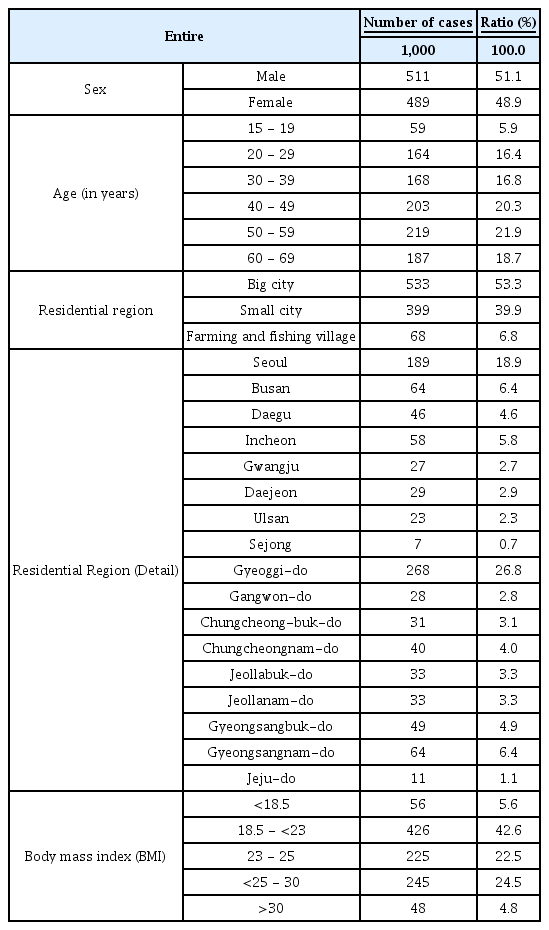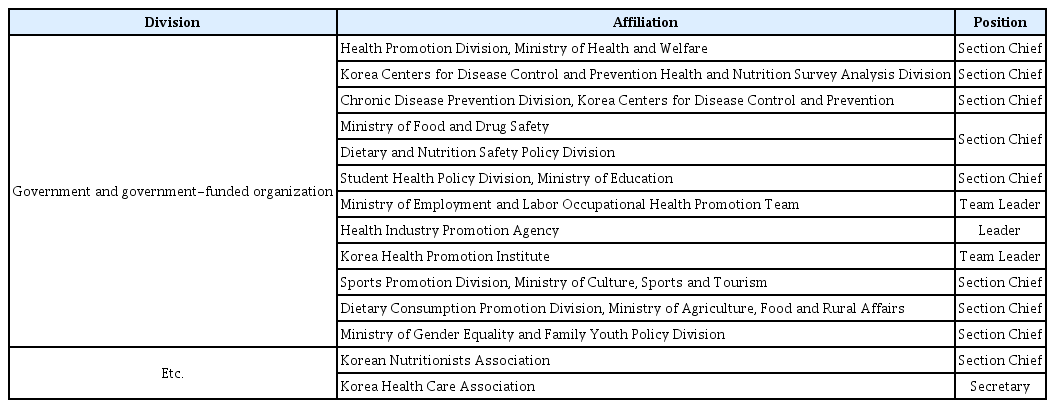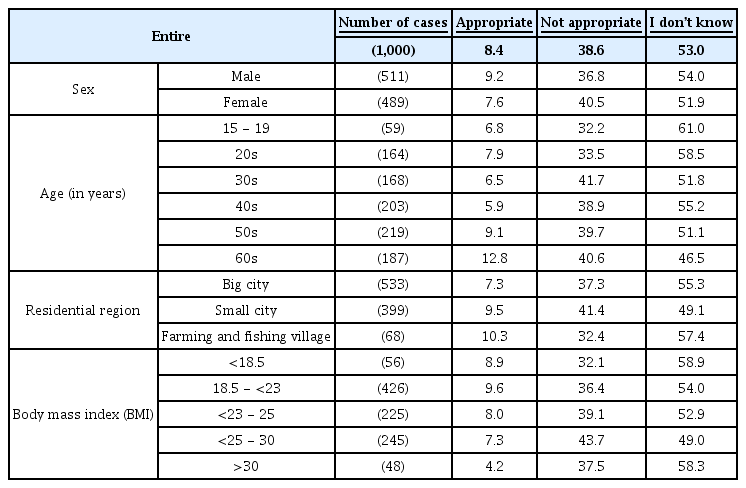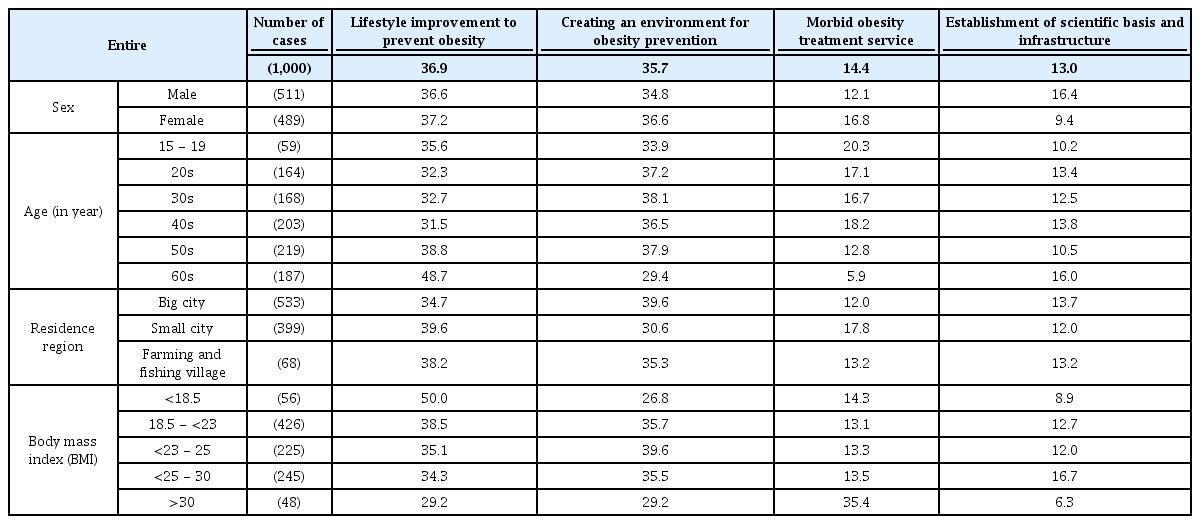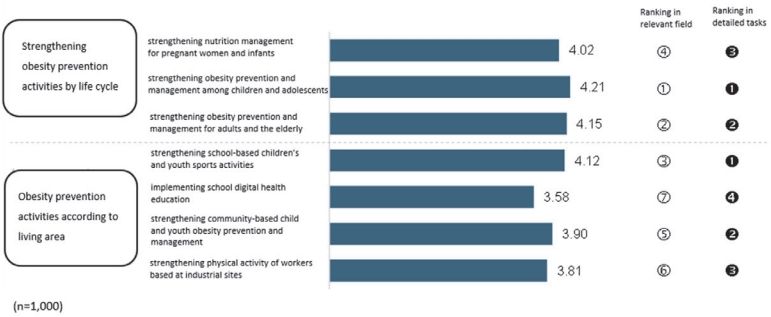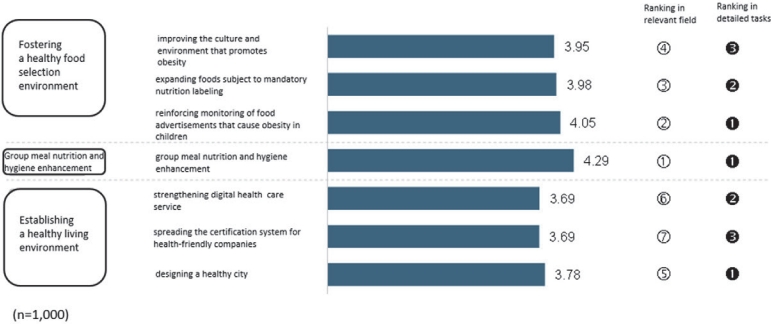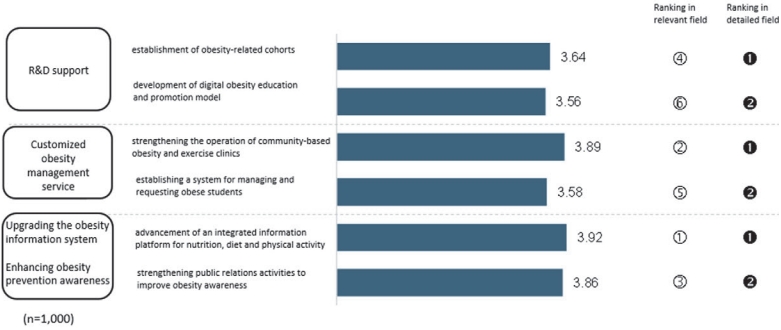Analysis of public perception of national obesity management policy
Article information
Abstract
[Purpose]
This study aimed to provide essential data necessary for shaping future obesity policy directions and strengthening the effectiveness of such measures.
[Methods]
A literature review and expert meetings were conducted to identify policy objectives that should be included in the comprehensive national obesity management plan. Based on these objectives, a questionnaire was developed, and a survey was conducted nationwide through an online panel targeting citizens aged 15-69.
[Results]
When analyzing the appropriateness of promoting national obesity policies, 38.6% of respondents answered “not appropriate,” while only 8.4% answered “appropriate.” We also assessed the importance of the four key areas of the national obesity management policy, with 36.9% considering “improvement of lifestyle to prevent obesity” as the most important. Additionally, we analyzed the significance of specific tasks. “Strengthening child and adolescent obesity prevention and management,” “enhancing group meal nutrition and hygiene,” “strengthening the operation of community-based obesity and exercise clinics,” and “advancing an integrated information platform for nutrition, dietary patterns, and physical activity” emerged as pivotal tasks within their respective areas.
[Conclusion]
The primary tasks identified as top priorities by the public in this study regarding national obesity policy initiatives can be incorporated into future obesity management strategies. Our approach has the potential to enhance the efficacy of these policies by aligning future obesity policy trajectories with public demands and expectations.
INTRODUCTION
Due to changes in the living environment driven by urbanization, unhealthy eating habits, and insufficient physical activity, the prevalence of obesity is increasing and emerging as a significant health concern. The World Health Organization classifies obesity as a major cause of various diseases and cancers [1]. By 2030, the prevalence of obesity in adults and children is expected to increase by 2.4% and 2.6% annually, respectively [2]. Obesity has emerged as an issue in developed countries, particularly in North America. However, it is now recognized as a global health problem, and Korea is no exception.
According to the 2021 National Health and Nutrition Examination Survey, the prevalence of adult obesity in Korea is 37.1%, indicating that over one in three individuals is obese. Obesity is linked to various diseases, including diabetes, hypertension, dyslipidemia, as well as fatty liver, vascular, and heart diseases, thereby increasing the obesity-related mortality rate by 20% [3]. As of 2019, the total socioeconomic loss attributed to obesity was estimated to be 13,852.8 billion, a 25.2% increase from 11,606 billion reported in 2015 [4]. Obesity is a serious medical condition and a significant health risk factor that contributes to a range of illnesses and substantially increases societal and economic expenses. Therefore, pan-governmental interest and policy cooperation are required.
The most effective approach to addressing obesity is prevention and management before it becomes widespread. Proactive policy interventions, as outlined by the Ministry of Health and Welfare in 2018, have the potential to prevent obesity. Accordingly, developed nations actively advocate obesity-related initiatives and campaigns on the national scale. The United States has been implementing a national obesity prevention policy, Let’s Move!, since 2010; Japan is also implementing an obesity prevention policy that encourages lifestyle changes, promotes physical activity, and improves diet [1]. Therefore, Korea is striving to prevent and manage obesity by implementing obesity-specific policies. However, an analysis of the outcomes from the 4th Comprehensive National Health Promotion Plan revealed that the prevalence of adult obesity did not achieve the intended outcomes but instead worsened [5]. Thus, despite acknowledging the importance of obesity prevention and management and endorsing obesity-related policies at a national level, the impact of these policies remains insufficient.
Ensuring an active response to policy targets is imperative for the successful implementation of government policies.The recipients’ perceptions of a policy profoundly influence its success or failure [6]. Furthermore, policies have the potential to effectively alter the behavior of their targets. To achieve this, it is paramount to discern the needs and perceptions of policy targets [7]. Therefore, comprehending and scrutinizing the perceptions of policy targets during policy development are crucial for augmenting policy effectiveness. In this context, a thorough examination of how the general public, as recipients of the policy, perceives the national obesity policy becomes indispensable.
To date, research on obesity policies has predominantly focused on the policy initiatives of public institutions. Studies investigating the existing state of child and adolescent obesity and policy measures [8,9] have been conducted. Furthermore, the Ministry of Health and Welfare conducted a study to develop an evaluation system for obesity prevention and management policies [10]. Despite the significance of the obesity policy, there is a notable gap in academic discussions and insufficient research, particularly regarding awareness of obesity policies in Korea. Therefore, this study examined public perception of the direction of the national obesity management policy, assessed the target audiences’ evaluation of domestic obesity policies, and identified areas and specific initiatives within which the obesity policy framework is considered important. We aimed to provide the basic data necessary for shaping future obesity policy trajectories and enhancing the effectiveness of obesity policies.
METHODS
Survey design and respondent characteristics
The survey was conducted nationwide through an online panel, targeting citizens aged 15-69. The sample was extracted using proportional allocation based on the population composition ratios of sex, age, and residential area. Residential areas were classified as large cities, small- and medium-sized cities, and rural areas, following the standards of the National Health and Nutrition Examination Survey. The survey took place over 12 days, from January 27 to February 7, 2023, and collected 1,000 responses. Respondents’ characteristics are presented in Table 1.
Questionnaire composition and data analysis
We conducted a literature review and expert meetings to identify the policy objectives to be included in the comprehensive national obesity management plan. A questionnaire was developed based on these findings. The literature review involved collecting data on domestic obesity policies, including the 1st National Comprehensive Measures for Obesity Management, national obesity policies and projects of each ministry, and academic papers on obesity policies. Additionally, we formed an expert council comprising 13 obesity policy experts from government agencies, academia, industry, related organizations, and research institutes to provide input on the direction and detailed tasks of the national obesity management policy. Two expert meetings were held on December 2, 2022, and February 2, 2023. The characteristics of the experts are listed in Table 2.
Through this process, we identified four areas of the national obesity management policy, comprising 11 tasks and 28 detailed tasks. The specific questionnaire items assessed the appropriateness of the current national obesity policy, categorizing them as “appropriate,” “inappropriate,” or “do not know.” The national obesity management comprehensive countermeasures field was configured to select the most important of the four areas. The significance of the detailed tasks in each field was assessed using a 5-point scale (ranging from 1 = “not at all important” to 5 = “very important”). Subsequently, we conducted a frequency analysis on the collected survey data using SPSS version 21.0.
RESULTS
Relevance of the national obesity policy promotion
Analysis of the appropriateness of the national obesity policy promotion revealed 38.6% and 8.4% responses for “not appropriate” and “appropriate, respectively.” Detailed results based on respondents characteristics are presented in Table 3.
Importance of each area and detailed tasks of the national obesity management policy
We assessed the importance attributed by the public to the four areas of the national obesity management policy identified in this study, along with the specific tasks within each area. The findings are as follows:
Importance of the four areas of the national obesity management policy
36.9% of the respondents selected “improvement of lifestyle to prevent obesity” as the most important, followed by “creation of an environment for prevention and management of obesity”, “provision of morbid obesity treatment service”, and “establishment of scientific basis and infrastructure” with 35.7%, 14.4%, and 13.0%, respectively. Detailed results based on respondents’ characteristics are presented in Table 4.
Importance of detailed tasks in the context of lifestyle improvement for obesity prevention
The significance of specific tasks within the lifestyle improvement domain in obesity prevention was assessed. Strengthening obesity prevention and management among children and adolescents emerged as a foremost task. When evaluating the significance of specific tasks within this domain, the hierarchy for strengthening obesity prevention activities by life-cycle stage was as follows: “strengthening obesity prevention and management among children and adolescents,” “strengthening obesity prevention and management for adults and the elderly,” and “strengthening nutritional management for pregnant women and infants.”
Meanwhile, for obesity prevention activities according to the living area, the tasks were ranked as follows: “strengthening school-based children’s and youth sports activities,” “strengthening community-based child and youth obesity prevention and management,” and “strengthening the physical activity of workers based at industrial sites.” A comprehensive breakdown of the significance of specific tasks within the lifestyle improvement domain for obesity prevention is shown in Figure 1.
Importance of specific tasks in the field of environment creation for obesity prevention and management
Upon analyzing the importance of specific tasks within the domain of environment creation for obesity prevention and management, “group meal nutrition and hygiene enhancement” was recognized as the most important task. When evaluating the significance of specific tasks within this domain, the hierarchy for fostering a healthy food selection environment was as follows: “reinforcing monitoring of food advertisements that cause obesity in children,” “expanding foods subject to mandatory nutrition labeling,” and “improving culture and environment that promotes obesity awareness.”
The importance of detailed tasks for establishing a healthy living environment ranked as follows: “activating a healthy city,” “strengthening digital health care services,” and “spreading the certification system for health-friendly companies.” Figure 2 illustrates the importance of specific environmental creation tasks for obesity prevention and management.
Importance of specific tasks in the domain of morbid obesity treatment service provision
“Strengthening the operations of community-based obesity and exercise clinics” is recognized as the most important task in the significance of specific tasks within the domain of morbid obesity treatment services. With the importance of specific tasks associated with strengthening education and counseling in this field, the ranking was “distribution and promotion of obesity intensive management guidelines” and “operating an online obesity counseling center.” Figure 3 presents detailed analysis results regarding the importance of specific tasks in the field of morbid obesity treatment service provision.
Importance of specific tasks in the field of scientific basis and infrastructure construction
“Advancement of an integrated information platform for nutrition, dietary pattern, and physical activity” was recognized as the most important task in the field of scientific evidence and infrastructure construction analysis. For the importance of detailed tasks in the relevant field, the importance of detailed tasks for research and development support ranked “establishment of obesity-related cohorts” the highest, followed by “development of digital obesity education and promotion models.” The importance of detailed tasks for customized obesity management services was in the order of “strengthening the operation of community-based obesity and exercise clinics,” followed by “establishing a system for managing and requesting obese students.” The importance of detailed tasks for upgrading the obesity information system and strengthening obesity prevention publicity ranked “advancement of an integrated information platform for nutrition, diet, and physical activity” highest, followed by “strengthening public relations activities to improve obesity awareness.” The results of the detailed analysis of the importance of specific tasks in the fields of scientific evidence and infrastructure construction are presented in Figure 4.
DISCUSSION
With the increasing obese population in Korea, the government has taken the lead in establishing mid- to long-term comprehensive measures related to obesity and in making efforts to prevent and manage obesity. However, various ministries have highlighted sporadic development and promotion of obesity-related policies and projects. As a result, the impact of obesity policies has been minimal, with only 8.4% of the target population believing that the national obesity policy was adequately promoted. This indicates that, despite the implementation of various obesity policies at the national level, satisfaction with these policies and their effectiveness remains low. Policy satisfaction is a crucial gauge for assessing the quality of a policy, offering valuable insights into the contentment of beneficiaries and enabling an evaluation of the tangible effects of the policy [11].
Emphasis on assessing policy effectiveness has recently grown in the policy realm, underscoring the emerging need to boost public satisfaction with policies [12]. Public expectations regarding health policies vary, and discerning the policies that resonate with them is critical [5]. Consequently, the recognition of policy targets and the development of obesity policies that address these needs are imperative, ultimately enhancing the efficiency of policies.
Preventing and managing obesity is crucial, and modifying an individual’s lifestyle can help prevent obesity [5]. Accordingly, among the four areas of the national obesity management policy, lifestyle improvements for obesity prevention have emerged as the most significant. However, the perceptions of importance varied according to the respondents’ characteristics. For individuals in their 20s and 40s living in large cities, the emphasis was on creating an environment conducive to obesity prevention and management. The global rise in obesity is evident in cities, and the need for obesity management policies to expand from individual behavioral improvements to urban environmental improvements is increasing [13]. Furthermore, large cities have a high ratio of single- and dual-income households, leading to an increased frequency of eating out. The infrastructure supporting takeout and delivery orders poses the risk of exposing residents to unhealthy dietary choices, thereby increasing the prevalence of obesity [14]. Young people living in large cities seem to recognize that creating an environment that helps prevent and manage obesity is the most crucial aspect of obesity management policies.
Meanwhile, respondents with a body mass index (BMI) ≥30 recognized that “providing morbid obesity treatment services” was the most important aspect. During the policy process, the degree of policy acceptance differs according to the degree of gains and losses among stakeholders [15]. Generally, a BMI ≥25 is classified as obese, ≥30 as severe obesity, and ≥35 as morbid obesity [16]. Essentially, respondents with a BMI ≥30 are considered to be highly aware of these policies because of eligibility for morbid obesity treatment services, allowing them to potentially gain from the policy.
In the field of lifestyle improvement for obesity prevention, “reinforcement of child and adolescent obesity prevention and management” was recognized as the most important task. Tasks targeting children and adolescents were evaluated as the most important. Childhood and adolescence are critical periods in establishing lifelong lifestyle habits. Given that over 80% of obesity is observed in childhood and adolescence [1], prioritizing the prevention and management of obesity in children and adolescents is imperative. According to a student health inspection sample survey announced by the Ministry of Education, the proportion of obese students in Korea was 19% as of 2021, showing a continuous increase over the preceding decade. Obesity in children causes physical and mental health problems, such as low self-esteem, depression, alienation from peers, emotional instability, and social adaptability [17].
Furthermore, as >80% of obesity in children and adolescents leads to obesity in adulthood, active responses are needed to reduce the national disease burden in the future [18,19]. Although a lack of physical activity in children and adolescents has been identified as one of the causes of obesity, the frequency of vigorous physical activity three or more times a week declines as students advance to senior years [1]. Revitalizing school physical education is a basic step in solving the obesity problem and is effective in preventing obesity in general students and managing student obesity [20]. In this context, a pressing need to implement policies that strengthen school-based physical activity among children and adolescents exists. These measures hold promise as practical strategies for curbing childhood and adolescence obesity.
The top four priorities regarding the significance of specific detailed tasks within the domain of environmental creation for obesity prevention and management were related to the dietary environment. This means that creating a healthy eating environment is key in establishing an environment for obesity prevention and management, and the public also recognizes this as important. Unhealthy eating habits have been frequently identified as the primary cause of obesity. Obesity occurs when an imbalance exists between energy intake and consumption. This can be a result of a marked decrease in physical activity; insufficient intake of fruits and vegetables; and a change in dietary intake patterns accompanied by an increase in the consumption of foods and beverages with high caloric density, low nutrient content, and high total fat, salt, sugar, and saturated fat [21].
According to the Ministry of Health and Welfare [22], fat intake in Korea will continue to increase, whereas fruit and vegetable intake will remain insufficient. Furthermore, issues related to nutritional intake and eating habits such as skipping breakfast and increasing sugar intake from processed foods persist. Accordingly, there is an emerging requirement for a policy that enhances nutrition and sanitation management for group meals, such as school meals. In addition, efforts should be made to strengthen the monitoring of food advertisements that contribute to obesity in children. In the United States, advertisements for junk food have been banned in schools to curb childhood obesity [1]. In this context, Korea should also promote restrictions on advertisements of high-calorie, low-nutrition foods, and high-caffeine-containing foods to enhance the monitoring of marketing strategies that may exacerbate childhood obesity. Furthermore, creating an environment in which people can choose healthy foods by expanding the number of foods subject to mandatory nutritional labeling is crucial.
However, a policy to revitalize healthy cities has been recognized as the most important factor in establishing a healthy living environment. Changes in lifestyle and living environments due to urbanization are the biggest factors contributing to obesity becoming a global epidemic, and the need to build urban environments to prevent obesity has emerged [13]. Therefore, establishing environments conducive to physical activity, such as sports facilities and urban parks, is essential. Equally, promoting the widespread adoption of “healthy city” principles to ensure these policies are activated is vital.
Obesity is defined as a BMI ≥25, and morbid obesity is a BMI ≥40 or ≥35 with complications [23]. The global prevalence of morbid obesity has been gradually increasing [24]. In Korea, the prevalence of morbid obesity in individuals with a BMI ≥35 and morbid obesity with a BMI ≥55 has been steadily rising over the past decade, and this trend is evident in younger age groups [25]. Accordingly, various policies for active treatment and support of morbid obesity are being promoted.
The first and second priorities in the field of morbid obesity treatment services pertain to detailed tasks within customized obesity management services. Although various obesity treatment methods are currently being performed, the treatment efficiency of fundamental obesity is low owing to challenges such as surgical treatment failure, drug addiction during treatment, depression, and significant time and economic investment. Therefore, a systematic and type-specific treatment approach for obesity is required [26]. Thus, to deliver treatment services for morbid obesity, customized management that fits the distinct characteristics of morbid obesity is required. The public recognizes the importance of this approach.
Furthermore, a policy for expanding the application of health insurance for morbid obesity treatment is also important. Most countries, including Japan, the United States, and the United Kingdom, apply health insurance to alleviate the burden of medical expenses and actively treat morbid obesity. Korea also applies health insurance for morbid obesity surgical treatments [1]. In addition to these treatments, promoting a policy to expand the application of health insurance to drug treatment, postoperative education, and counseling is crucial, thereby easing the burden of medical expenses and actively treating morbidly obese individuals.
The public recognizes that advancing an integrated information platform for nutrition, dietary patterns, and physical activity is important in establishing scientific evidence and infrastructure. Obesity prevention tasks in Korea are scattered across various ministries, affiliated organizations, and local government departments. This decentralized approach has led to the redundancy of similar obesity projects, primarily owing to the lack of coherent coordination and collaboration between related ministries and agencies [27]. Approximately 40 websites and applications are dedicated to dietary and nutritional information, each managed by a separate ministry [1]. Therefore, it is necessary to link the information systems related to nutrition, dietary patterns, and physical activity, which are distributed and operated by each ministry, and establish an integrated information platform to improve policy effects through policy linkages by sector.
Strengthening public relations activities to improve awareness of obesity is crucial. In Korea, a social trend of recognizing obesity as a cosmetic problem, rather than a disease, is prevalent, and public awareness regarding the need to prevent and manage obesity is lacking [1]. Accordingly, obesity awareness needs to be improved, and publicity activities for obesity policies need to be strengthened. Familiarity with a policy tends to increase an individual’s propensity to engage with or utilize it [28-30]. Diverse promotional strategies must be adopted to ensure the efficacy of policies. The primary aim is to elevate public consciousness regarding these policies, enabling a wider demography to access the support or services provided [31].
Furthermore, policy publicity remains a significant avenue for garnering consent and support for policies [32], exerting an influence on public attitudes and opinions concerning policies [33]. Therefore, strengthening publicity efforts to promote diverse obesity policies is crucial. This will enable more people to benefit from the policies and contribute to positive evaluations.
This study aims to identify the direction of national obesity management policies and specific policy tasks. We examined how the public perceives the suggested direction of the national obesity management policy. Thus, we deduced policy implications for enhancing the efficacy of obesity management strategies.
Recognizing policy preferences and evaluating policy effectiveness necessitate an understanding of prior expectations of the public regarding government policy, or the measurement of their subjective satisfaction [11]. This study is significant as it thoroughly investigates the perception of domestic obesity policies. It delves into how individuals, who are the direct targets of these policies, assess them. Furthermore, it identifies areas and specific projects within the policy that are deemed important.
Recently, a growing recognition of the need to utilize the viewpoints of policy stakeholders or the public as the foundation for government decision-making has emerged [34]. Hence, the primary tasks that the public perceives as top priorities in national obesity policy initiatives identified in this study must be incorporated into future obesity management strategies. By shaping future obesity-policy trajectories rooted in public demand and expectations, we posit that this will amplify the efficacy of these policies. This study is meaningful in that it identifies the policy priorities recognized by the public, who are the actual policy targets for the national obesity policies. However, this study was limited because public opinion was not collected during the initial phase of establishing a national obesity policy direction. Consequently, conducting follow-up studies to collect public opinions on the future direction of national obesity policies is crucial.
